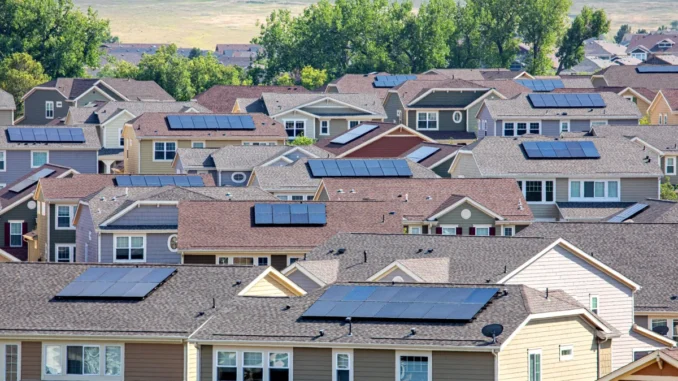
A freshman lawmaker in Rhode Island has opened a provocative discussion: why not mandate solar panels on most new construction?
Rep. Jennifer Boylan, a Democrat who has solar panels on her home in Barrington, said she sees every instance in which a new building goes up without solar panels as “a missed opportunity.”
So she drafted a bill that would require all new single-family dwellings in the state to have a solar energy system large enough to meet at least 80% of the dwelling’s estimated annual average electricity use. The mandate would also apply to multifamily dwellings and commercial buildings up to 10 stories high.
In addition, all new outdoor parking lots larger than 16,000 square feet would be required to install raised solar canopies over at least half of their surface. Five percent of spaces would have electric vehicle charging stations.
“The time has come to start having conversations about building things with solar from the get-go instead of as an afterthought,” Boylan said during a public hearing on the bill last week before the House Committee on Corporations.
California is the only state that has a solar mandate on new construction. The California Energy Commission approved requirements for solar on new single-family homes and multifamily dwellings up to three stories high as of 2020. This year, additional provisions went into effect requiring solar power and battery storage in many new commercial structures and high-rise residential buildings.
Sign up for Energy News Weekly
Get the most important energy news of the week delivered directly to your inbox.
“It’s been incredibly effective,” said Ben Davis, a policy associate with the California Solar and Storage Association. “I live in a neighborhood with a ton of new construction. Every single building has solar on it, which is fantastic to see. The buildings are designed with solar in mind, so there’s a cost savings for permitting, and you don’t need to do any rewiring.”
Several states are now considering following California’s lead. Solar mandate legislation is pending in Massachusetts; Boylan said she borrowed heavily from that bill for her draft.
And in New Mexico, a bill to require home builders to offer buyers installed solar in new construction has passed the Senate and is awaiting a vote in the House.
“Building all new homes with enough solar capacity to meet their electricity needs will be a key part of America reaching 100% clean, renewable energy,” said Johanna Neumann, senior director of clean energy programs for Environment America.
Research conducted by that organization in 2018 concluded that installing solar panels on all new homes in the U.S. from 2020 to 2026 would result in more solar energy capacity than the entire country installed in 2020, Neuman said.
The report broke down the projected gains by state. Putting solar on all new homes in Rhode Island from 2020 to 2045 would give the state an estimated 255 megawatts of additional solar energy. The state had almost 600 megawatts of installed solar capacity as of last year, according to the U.S. Energy Information Association.
Over the last few years, Rhode Island towns have issued around 1,400 building permits annually for single-family and multifamily homes, according to U.S. Census data.
But during last week’s public hearing, committee member Rep. Brian Newberry, a Republican representing Burrillville and North Smithfield, questioned whether it is wise to add to the cost of a new home by mandating solar, given how high home prices are already. He cited an estimate from the California Energy Commission that the mandate added between $8,000 and $10,000 to the cost of a new home there.
In addition, he said, it should be a matter of personal choice.
“A lot of people might not want solar on their house,” he said. “I don’t want solar panels on my house.”
Boylan acknowledged the upfront cost, but said the system pays for itself over time in reduced energy costs. She said she recouped the cost of the solar panels on her home in seven years.
The California Energy Commission has projected that the upfront cost of solar on a new home is more than offset by about $19,000 in energy savings over a 30-year period. The cost of electricity in Rhode Island is slightly less than in California but still comparable.
The Rhode Island Builders Association also opposes a mandate.
“There are a lot of ideas on how to remove carbon-based energy from homes, and the issue is much more complex than mandating a particular solution over others,” said John Marcantonio, the association’s chief executive officer.
The legislation does allow for some exceptions. Properties may be exempted if a developer establishes that there is “no practical way” to design the home or project to accommodate solar. And the bill says they are not required to remove trees in order to comply.
An exemption would also apply if the developer showed that a substitute renewable energy system would be installed at the time of construction.
And affordable housing developments would be exempt if developers could not find a “viable source” to fund the inclusion of solar.
Sue AnderBois, climate and energy program manager for the Rhode Island Nature Conservancy, testified in support of the bill.
“Renewable-ready construction just makes sense if we know we need to move to a clean energy future,” she said.
Rhode Island has a track record when it comes to requiring energy-efficient construction. Last year, lawmakers expanded the state’s 2009 Green Buildings Act, which now requires that all state and municipal buildings larger than 10,000 square feet must be LEED certified. However, the State Energy Conservation Code for building construction still references the 2015 International Energy Conservation Code, not the most up-to-date version, according to ACEEE.
Boylan said she expects that the possible adoption of a solar mandate will require a lot of input from a host of stakeholders. Her intent was to get that conversation going.
“I see this as a multiple-year effort,” she said. “This is year one.”
Source: energynewsbeat.co

